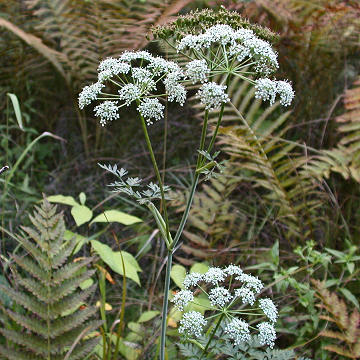

Conioselinum chinense - (image 1 of 4)
Taxonomy
Family: Apiaceae
Habitat
Swamps, bogs, fens, wet meadows.
Associates
Distribution
Labrador and Newfoundland to MN, south to PA, IN, IA and south in mountains to NC. Also in China.
Morphology
Perennial from a cluster of fibrous roots, to 1.5 m at maturity. Leaves 2-3 compound, 10-20 cm, on elongate petioles; leaflets lanceolate to ovate, 1.5-4 cm, pinnatifid. Flowers in few true umbels 3-12 cm wide, petals white, stylopodium (enlargement of the base of the style) conic; fruit smooth and dorsally flattened, 2.5-4.5 mm; mature fruit has a deeply bifid carpophore (elongated section of the receptacle between the carpels as a central axis).
Notes
Flowers late August to September
Wetland indicator: Obligate
Populations appear to be secure in NY state but it is listed as endangered in several other states according to the USDA. The specific epithet references the fact that this plant also occurs in China. There is currently an entry for this species in the Flora of China but none yet for the Flora of North America. The leaves resemble Wild Carrot while the flowers look very much like Poison Hemlock (Conium maculatum). The genus is a concatenation of the latter genus and Selinum, another genus in the carrot family native to Europe and Asia..
References
Gleason, Henry A. and A. Cronquist. 1991. Manual of Vascular Plants of
Northeastern United States and Adjacent Canada. Second Ed.
The New York Botanical Garden. Bronx, NY
Swink, F. and G. Wilhelm. 1994. Plants of the Chicago Region.
Indiana Academy of Science. The Morton Arboretum. Lisle, Illinois.
|
Michael Hough © 2010 |